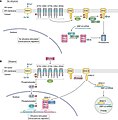File:Ethylene signaling pathway.jpg

Size of this preview: 591 × 599 pixels. Other resolutions: 237 × 240 pixels | 473 × 480 pixels | 757 × 768 pixels | 1,262 × 1,280 pixels.
Original file (1,262 × 1,280 pixels, file size: 217 KB, MIME type: image/jpeg)
File history
Click on a date/time to view the file as it appeared at that time.
| Date/Time | Thumbnail | Dimensions | User | Comment | |
|---|---|---|---|---|---|
| current | 12:06, 12 June 2021 |  | 1,262 × 1,280 (217 KB) | Chhandama | Uploaded a work by Brad M. Binder from Binder B. M. (2020). Ethylene signaling in plants. The Journal of biological chemistry, 295(22), 7710–7725. https://doi.org/10.1074/jbc.REV120.010854 with UploadWizard |
File usage
The following pages on the English Wikipedia use this file (pages on other projects are not listed):
Global file usage
The following other wikis use this file:
- Usage on ar.wikipedia.org
- Usage on de.wikipedia.org
